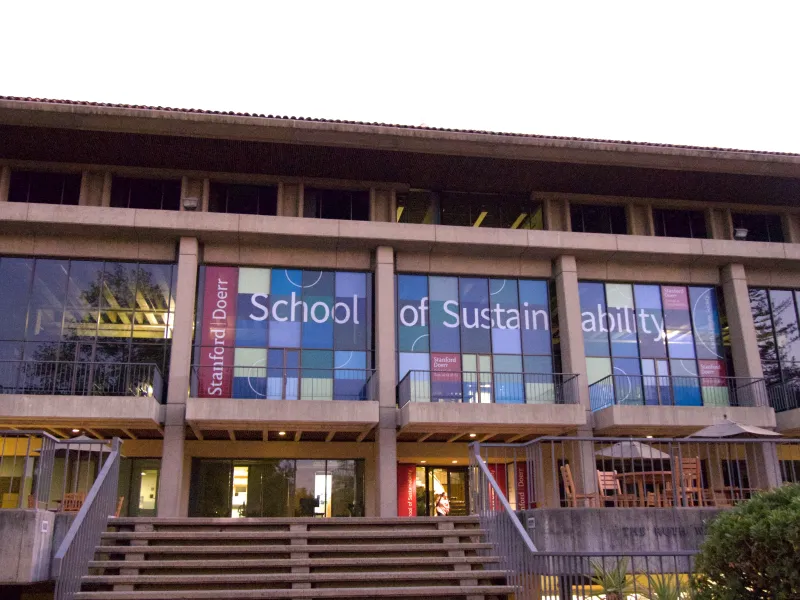Like most students at Stanford, I hadn’t heard of environmental justice before arriving here. I was passionate about ecology and conservation, areas I thought lay clearly separated from social change. But as I learned from frontline communities, professors, classes and clubs, I saw how wrong I was and how inseparable issues of justice were from environmental protection. Justice, and therefore environmental stewardship, spins through everything.
But as I have engaged deeper with environmental spaces at Stanford through the Environmental Justice Working Group, I have begun to recognize a critical gap in the center of our efforts in sustainability. I’m a scientist, and I’m also a writer and artist. And as I’ve worked with the Doerr School and seen its potential as a space to foster transformative futures, I’ve also seen how much it could benefit from engaging deeper with environmental justice artists and incorporating more of the humanities into its processes and structures.
The Doerr School cites environmental justice as one of its key foundations, and art has never been separable from environmental justice. Environmental justice (EJ) is a movement that calls attention to disproportionate environmental impacts based on race. Formalized in a set of 17 principles at the 1991 First National People of Color Summit, environmental justice has since grown into a movement and respected field of scholarship that spans all levels of power, knowledge and access. At its heart, EJ uplifts the voices and leadership of people of color and marginalized communities. It connects freedom from oppression with healing our relationship with Mother Earth. EJ believes a just future is one where historical injustice against communities of color is healed, and that no sustainability exists apart from that healing. It asserts that all things — whether ecological, human or animal — are fundamentally interconnected. As such, harms enacted on one part, ultimately, ripple outwards to impact everyone. Creating a better world in EJ means paying reparations for violence. It does not allow the segmentation of one issue from another; it recognizes everything touches everything else. For every question, EJ asks who is involved. It recognizes every political as personal.
Nearly every major EJ movement has included art and artists at its heart. By its nature, art encourages breaking disciplinary rules. It allows us to imagine beyond a constrained set of tools for pre-defined exploration and knowledge generation. It lets us think beyond our current realities. Researchers have recognized art as “the missing anchor” in environmental action.
As such, for the scale of our current crises, which requires solutions that envision worlds out of our reach, creating opportunities to engage for art is critical to letting us imagine beyond, past and through. Science scaffolded on centuries of ivory tower knowledge struggles with seeing past that ivory tower. But art can imagine what it would look like to see the tower topple, and can show us what the world could look like, even if we can’t conceptualize it yet ourselves.
The Doerr School’s formal engagement with the humanities is still nascent. Classes like Environmental Humanities have begun to offer options to students to explore how sustainability and the humanities interact, but structurally the institution has committed only to the departmentalization of behavior studies and environmental policy. But its opportunity for a radically impactful sustainability effort could be broadened even more if it also institutionalized homes for artists and thinkers to grapple in non-scientific arenas with the biggest problems of our time.
EJ offered me the idea that the personal imbues everything with value by illuminating the connections that bind us all. And it pushes me to imagine beyond current realities, past current frameworks, beyond current institutions, towards possibilities where structures of violence and harm do not exist. But I’m realizing that the tools I’ve been given so far through my education in institutionalized science do not lend themselves, by their nature, to that kind of disruption. And I’ve begun to recognize the value of environmental art — not just as a way of translating science for more popular consumption, or of raising awareness about issues already solidified in academic circles, but rather as a way of pushing us forward towards futures and possibilities we can’t see yet.
At the Environmental Justice Working Group and places beyond, my teachers, friends, partners and I envision a Doerr School that uplifts the environmental justice humanities to create the revolutionary change necessary for a sustainable planet. The work is already happening. Stanford has incredible environmental justice artists and art spaces that have been flourishing here for years: the annual Earthtones festival, happening again this May, unites radical and beautiful forms of creation from around the Bay Area and beyond. And this year, more and more artists, storytellers and musicians with environmental justice at the heart of their oeuvre have been visiting campus, from the trailblazing Ghanaian musician Okaidja Afroso to the Oakland-based Movement Generation. But these invitations shouldn’t only come because individual departments, labs or students took initiative, or in a once-yearly festival — what if we had concerted residencies in the Doerr School? What if partnerships and fellowships with spaces like Stanford’s Institute for Diversity in the Arts allowed students to devote focused time to exploring the intersections of sustainability and art? What if the Doerr School’s definitions of innovation included technological and scientific advances alongside artistic and ideological boundary-breaking? What would a sustained institutional commitment to that look like?
The Doerr School has an extraordinary opportunity to describe all the possibilities a just future offers us. And just like there is no one kind of justice, there is no one kind of imagined future environmental art can offer us. They are as varied and complex and brilliantly radical as the people creating them.
Tanvi Dutta Gupta is a senior studying biology on the ecology and evolution track. She serves as a student co-lead of the Environmental Justice Working Group, where she works with the EJ and Arts committee.
